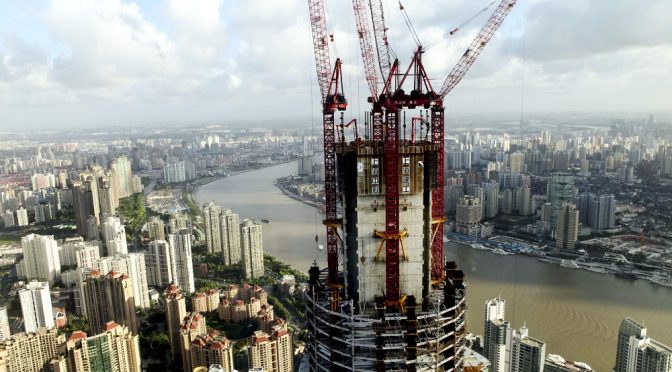China is offering the world a better way to move forward. It is not perfect, and has nothing to do with exotic technologies yet, at least not for now. But it is far better than what the West is trying to do, even to its own population. It has achieved so much in a relatively short time, i.e. has caused the upliftment of at least 800 million for the last 3 decades.
More than that, the massive development has encouraged its people to aim as high as imagination and engineering could reach.
A Chinese company wants to build the tallest structure on the planet in just 3 months!

The world’s tallest building took five years to reach its 828-meter, 2,716-foot height, but a Chinese company wants to leave the Burj Khalifa in the dust.
China will be building skyscrapers at much faster construction time than the convention using prefabricated modules and parts.
Broad Sustainable Building, which already built a hotel in two weeks, aims to erect the new Sky City skyscraper within three months.
After overtaking the United States as the biggest construction market in 2010, China’s construction sector will more than double in size to $2.5 trillion by 2020.

A Chinese construction laborer works on new, massive construction site in downtown Beijing March 14, 2011.
Chinese infrastructure constructions, as we already know, are not just happening in China, but are spread across continents willing to work and develop with her, constructively.
China’s old Silk Road revival: hi-speed trains, massive skyscrapers and free-trade zones
https://www.youtube.com/watch?v=DosxS4Iofek
RT | Jun 22, 2017
- The Ancient Silk Road was a major trade route that linked Europe and Asia between the 2nd century BC and the late 16th AD.
- Modern China is a rapidly growing economy. “One Belt, One Road” is an initiative to revive the Silk Road to help the country play a bigger role in global affairs.
- Ancient towns that were once key outposts on the Silk Road are undergoing rapid growth both economically and in infrastructure as they are to reprise their roles as major trading waypoints along the route
- Citizens now enjoy new business opportunities and contribute further to developing their cities
In its heyday, the ancient Silk Road was Eurasia’s most important trade route, connecting two rich continents to facilitate trade and cultural exchange. Modern-day China has seen near constant economic growth. It boasts of several record figures, including the highest number of skyscrapers and the longest railroads. Five years ago, the government announced a new plan, “One Belt, One Road”, an initiative to revive the Silk Road. The strategy seeks to help China play a bigger role in global affairs through developing an infrastructure that will unite the countries of the two continents under a cohesive economic area.
Many ancient Chinese cities that were once outposts along the Silk Road, desert oases or transport hubs are now rapidly transforming themselves into megacities, so that they can, once again, service and profit from the trade route. New businesses are opening, facilitated by the development of a reliable transport system, which in turn brings greater tourist flow. Some cities are also grated the status of special economic area, offering attractive tax incentives to foreign investors.
We visit two very different cities; Lanchjou and Urumchi, united by the Silk Road’s history. Both are experiencing rapid development. We meet businessmen who tell us how it feels to watch their home towns transform into economically and politically significant conurbations and how it inspires them to aim for international markets and seek new outlets for their businesses to grow.
http://bit.ly/1MgFbVy



Incredible, Get on board the Win Win, Peace Train, BY Bye Rotschild & Scum!
Seeeeeeeeeee That way it will become MUCH easier to CONTROL the populations for OUR (cabal’s)benefit1 Hehehehehehhehehhehehe!
GIVE ME A BREAK!!! (LAUGH!!!)
Chinese government = state competence, hands down…. very much unlike USA Inc., Rothschilds and Western mainstream whatever who only focus on upending others with their destructive power.
Can you say covertgeoplitics, what the MAIN FACTOR is for china’s economic success that enabled its huge rise to do these public works? (cos Im stumped to what it is specifically):
– Is it its communist mentality of nationalizing all infrastructure (mostly banking) to stop corruption and profiteering?
– Is it its cheap labor that simply priced everyone else out of business (industrially cheap products to near monopoly level$$)?
– Is it its population controls that curbed consumption? Cos its very concidental that china took off at the exact same time they implemented a one child policy in the 70s.
With full consideration of the items you’ve stipulated, the main difference between the East and West paradigm is the end goal which dictates the policies to get there.
China knows that it is only as strong as its people are. Except for Saudi Arabia, et al, there is a strong desire for Eastern countries to genuinely improve the lives of its people within the limitation of the prevailing system that the West imposed.
The Western Oligarchy’s strength lies on its military, dark methods and assassins, solely for the benefit of the bloodlines.
Once the East achieved the economic and military strength required to confront the Western powers, it would then initiate a new global system, in this case a multipolar world, which would enhance cooperation while respecting unique cultures. In a way, this end goal still serves China’s interest in a much larger scale, i.e. putting in check the misuse of too much power.
We are already halfway at this point.